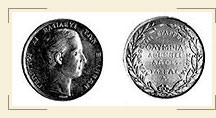|
The Olympia of Zappas
With a letter to the king of Greece Evangelos Zappas, a wealthy Greek settled in Bucharest, offered the money for the restoration of the Olympic Games. This was not the first time that this idea presented itself. The request of Alexandros Soutzos had preceded (1834) as well as the effort of the municipality of Letrini (1838), while in England William Brooks organized as early as from 1850 his own version of the Olympic Games. Zappas' intention was to finance a purely sports event. Nevertheless, at that time sport constituted an unknown activity to the Athenian capital and to the Greek society in general. There were no gymnasiums, or sports associations, either private or university, whereas gymnastics was provided as a form of exercise only to military schools as a necessary element for the training of officers. This was not the first time that this idea presented itself. The request of Alexandros Soutzos had preceded (1834) as well as the effort of the municipality of Letrini (1838), while in England William Brooks organized as early as from 1850 his own version of the Olympic Games. Zappas' intention was to finance a purely sports event. Nevertheless, at that time sport constituted an unknown activity to the Athenian capital and to the Greek society in general. There were no gymnasiums, or sports associations, either private or university, whereas gymnastics was provided as a form of exercise only to military schools as a necessary element for the training of officers.
Therefore, upon proposals from members of the government the organization of an agricultural and industrial exposition was decided, which would include sports games under the name Olympia. Zappas accepted the proposal and in 1859 were published the regulation of the games, the contests and the prizes (money, diploma, olive branch). Due to the absence of a gymnasium, the games took place in Louis square (later Omonoia square) on 15 November 1859. The programme of the games included certain ancient-like and rather odd contests, such as the javelin throw towards a specific target, the climbing on a cloth smeared with soap etc. These contests were the most popular among a numerous but athletically uncultivated audience. The first Olympia reminded more of acrobatic happenings and other similar popular demonstrations of physical strength held on feasts and holidays usually at some square. Spectators and athletes participated in a culture of physical management quite different from that, which was organized around the gymnastic and sports activities.
Despite all that, Evangelos Zappas increased his donation, with a view to constructing an exhibition hall where the agricultural and industrial exposition could be held, as well as a gymnasium for the staging of sports games. The political upheaval of the period 1859-1864 (Otto's dethronement, interregnum) did not make the materialization of those decisions possible. The normalization of the political life brought Zappas' offer to the fore once again. As a result, in 1865 the Committee for the Olympia was set up in order to administer the legacy, build the hall and the gymnasium and organize the games every four years. At that time there was only one gymnasium in Athens, the Dimosio, which was run by a German gymnast and a Greek acrobat, Tziotis. Those men undertook the organization of the second Zappeian Olympiad, which was finally held in 1870, in November again, without any significant qualitative differences compared to the first one. However, this time, the games were carried out in the makeshift track of the Panathenaic Stadium.
The third Olympia were held in 1875. Ioannis Fokianos, manager of the Dimosio gymnasium and gymnast, and an adherent of the German system of gymnastics, was responsible for the competition part. Fokianos tried to change the programme of the games, reducing the bizarre contests of the previous games and adding gymnastic contests. However, the latter were never carried out due to the very bad organization, for which he was held responsible. The failure of the games, despite Fokianos' effort to make them more gymnastic, was associated with the absence of sports activity in Athens and with the lack of sports infrastructures. During the following years the committee which handled the legacy of Zappas centred its attention on the construction of the exhibition hall and the gymnasium.
Indeed, in 1878 the Central Gymnasium was built and in 1887 the Zappeion was completed. At the same time the first sports activity was produced, the first efforts were made for the foundation of sports associations and gymnastics was introduced in education as a compulsory discipline. What is more, a relatively steady group of people, students in particular, who exercised regularly, converged around Fokianos in the Central Gymnasium and constituted the first organized sports nucleus in the Greek capital.
These developments set perforce the need for competitive activity. Therefore, on the initiative of Fokianos and without any economic or other support from the Committee for the Olympia, the fourth Zappeian Olympiad was organized in May 1889. This time the programme of the games included gymnastics events, track and field events and weightlifting, as well as student demonstrations. The games were held at the Central Gymnasium and the participating athletes were among those who frequented the Central Gymnasium.
The fourth Olympia (1889) can be regarded as the first sports games held in Greece, until the turning point, namely the transition from "acrobatic" to gymnastic sport. At the same time, though, they were the last of the series of the Zappeian Olympiads. The problems of liquidation and transfer of Zappas' property to Greece did not allow the continuation of the institution, at a time when sporting activity was a limited but dynamic reality for the middle and upper classes of the Athenian society. Therefore, the end of the institution did not signify the end of sports activity, but its beginning instead. The responsibility for the organization of sports games was handed over, through Fokianos, to the sports associations that had been founded in the early 1890s.
|